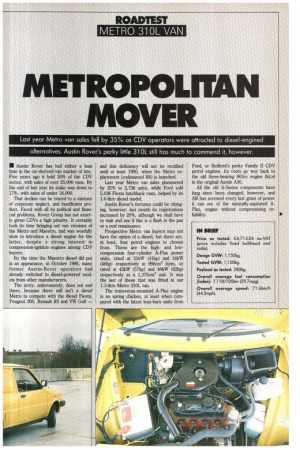METROPOLITAN MOVER
Page 47

If you've noticed an error in this article please click here to report it so we can fix it.
• Austin Rover has had rather a lean time in the car-derived-van market of late. Five years ago it held 30% of the CDV sector, with sales of over 25,000 vans. By the end of last year its stake was down to 17%, with sales of under 18,000.
That decline can be traced to a mixture of corporate neglect, and insufficient product. Faced with all its political and financial problems, Rover Group has not exactly given CDVs a high priority. It certainly took its time bringing out van versions of the Metro and Maestro, and was woefully slow to introduce a diesel engine for the latter, despite a strong interest in compression-ignition engines among CDV buyers.
By the time the Maestro diesel did put in an appearance, in October 1986, many former Austin-Rover operators had already switched to diesel-powered models from other manufacturers.
The story, unfortunately, does not end there, because there still isn't a diesel Metro to compete with the diesel Fiesta, Peugeot 205, Renault R5 and VW Golf — and this deficiency will not be rectified until at least 1990, when the Metro replacement (codenamed R6) is launched.
Last year Metro van sales plummeted by 35% to 3,736 units, while Ford sold 5,036 Fiesta hatchback vans, helped by its 1.6-litre diesel model.
Austin Rover's fortunes could be changing, however: last month its registrations increased by 20%, although we shall have to wait and see if this is a flash in the pan or a real renaissance.
Prospective Metro van buyers may not have the option of a diesel, but there are, at least, four petrol engines to choose from. These are the highand lowcompression four-cylinder A-Plus power units, rated at 31kW (41hp) and 34kW (46hp) respectively in 998cm3 form, or rated at 43kW (57hp) and 46kW (62hp) respectively as a 1,275cm3 unit. It was the last of these that was fitted in our 1.3-litre Metro 310L van.
The transverse-mounted A-Plus engine is no spring chicken, at least when compared with the latest lean-burn units from Ford, or Bedford's perky Family II CDV petrol engines. Its roots go way back to the old three-bearing 803cc engine fitt...-d in the original Austin A30.
All the old A-Series components have long since been changed, however, and AR has screwed every last gram of power it can out of the naturally-aspirated APlus, engine without compromising reliability.
























































































